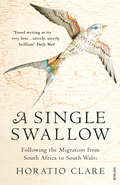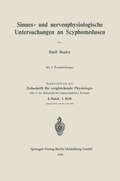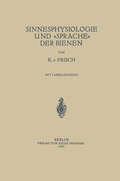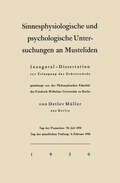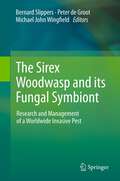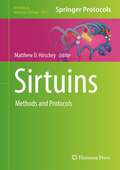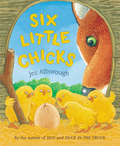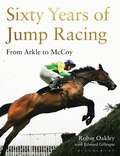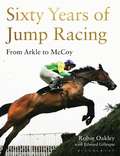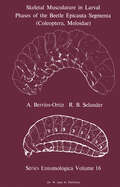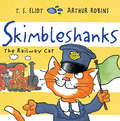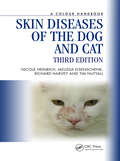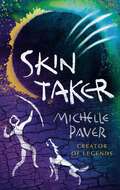- Table View
- List View
A Single Swallow: Following An Epic Journey From South Africa To South Wales
by Horatio ClareFrom the slums of Cape Town to the palaces of Algiers, through Pygmy villages where pineapples grow wild, to the Gulf of Guinea where the sea blazes with oil flares, across two continents and fourteen countries - this epic journey is nothing to swallows, they do it twice a year. But for Horatio Clare, writer and birdwatcher, it is the expedition of a lifetime. Along the way he discovers old empires and modern tribes, a witch-doctor's recipe for stewed swallow, explains how to travel without money or a passport, and describes a terrifying incident involving three Spanish soldiers and a tiny orange dog. By trains, motorbikes, canoes, one camel and three ships, Clare follows the swallows from reed beds in South Africa, where millions roost in February, to a barn in Wales, where a pair nest in May.
Sinne und Verhalten: aus dem Leben einer Spinne
by Friedrich G. BarthSpinnen sind wundervolle Kreaturen. Ihr reichhaltiges und komplexes Verhalten verfügt über hochentwickelte Sinnessysteme und ist hervorragend an die Bedingungen ihrer Umwelt angepasst - wie sich aus ihrem evolutionären Erfolg ersehen lässt: sie hatten 400 Millionen Jahre Zeit, ihre Biosensoren zu einer faszinierenden technischen Perfektion und Komplexität auszuarbeiten. Professor Friedrich G. Barth stellt in seinem packenden Buch diese "technische Perfektion" in den übergeordneten Zusammenhang der "Biologie", in der die Passung zwischen Umwelt und Sinnesorganen und die Selektivität der Sinne als Bindeglied zwischen Umwelt und Verhalten eine vorranginge Rolle spielt.
Sinnes- und nervenphysiologische Untersuchungen an Scyphomedusen
by Emil BozlerDieser Buchtitel ist Teil des Digitalisierungsprojekts Springer Book Archives mit Publikationen, die seit den Anfängen des Verlags von 1842 erschienen sind. Der Verlag stellt mit diesem Archiv Quellen für die historische wie auch die disziplingeschichtliche Forschung zur Verfügung, die jeweils im historischen Kontext betrachtet werden müssen. Dieser Titel erschien in der Zeit vor 1945 und wird daher in seiner zeittypischen politisch-ideologischen Ausrichtung vom Verlag nicht beworben.
Sinnesorgane und Leuchtorgane
by Otto BütschliDieser Buchtitel ist Teil des Digitalisierungsprojekts Springer Book Archives mit Publikationen, die seit den Anfängen des Verlags von 1842 erschienen sind. Der Verlag stellt mit diesem Archiv Quellen für die historische wie auch die disziplingeschichtliche Forschung zur Verfügung, die jeweils im historischen Kontext betrachtet werden müssen. Dieser Titel erschien in der Zeit vor 1945 und wird daher in seiner zeittypischen politisch-ideologischen Ausrichtung vom Verlag nicht beworben.
Sinnesphysiologie und »Sprache« der Bienen
by K. v. FrischDieser Buchtitel ist Teil des Digitalisierungsprojekts Springer Book Archives mit Publikationen, die seit den Anfängen des Verlags von 1842 erschienen sind. Der Verlag stellt mit diesem Archiv Quellen für die historische wie auch die disziplingeschichtliche Forschung zur Verfügung, die jeweils im historischen Kontext betrachtet werden müssen. Dieser Titel erschien in der Zeit vor 1945 und wird daher in seiner zeittypischen politisch-ideologischen Ausrichtung vom Verlag nicht beworben.
Sinnesphysiologische und psychologische Untersuchungen an Musteliden: Inaugural-Dissertation zur Erlangung der Doktorwürde genehmigt von der Philosophischen Fakultät der Friedrich-Wilhelms-Universität zu Berlin
by Detlev Müller-UsingDieser Buchtitel ist Teil des Digitalisierungsprojekts Springer Book Archives mit Publikationen, die seit den Anfängen des Verlags von 1842 erschienen sind. Der Verlag stellt mit diesem Archiv Quellen für die historische wie auch die disziplingeschichtliche Forschung zur Verfügung, die jeweils im historischen Kontext betrachtet werden müssen. Dieser Titel erschien in der Zeit vor 1945 und wird daher in seiner zeittypischen politisch-ideologischen Ausrichtung vom Verlag nicht beworben.
Sinnhafte Strukturen des Handelns und neurobiologische Prozesse des Sehens: Zur soziologischen Bestimmung von Wahrnehmen als Handeln sowie zur Kritik der neurowissenschaftlichen Rede über Gehirn, Bewusstsein und visuelle Wahrnehmung (Edition KWV)
by Olaf Behrend„Die Schwierigkeit ist, um darauf nochmals hinzuweisen, einen Gedanken zu denken, der den Funktionen der neuronalen Vorgänge tatsächlich gerecht wird, nämlich dass die neuronale Aktivität der neuronalen Areale unser bewusstes Sehen realisiert bzw. ist, ohne dass das Sehen dort wäre oder wir dort im Kopf etwas sähen oder Neuronen dort etwas repräsentierten. Denn das Sehen ist eine Relation, und das Gesehene ist dort, wo wir es mit den Augen sehen.“Die 2008 erstmals erschienene Studie gibt sowohl einen grundsätzlichen Einblick in die neurophysiologischen Grundlagen des Sehens als auch und vor allem eine differenzierte Diskussion und Kritik neurowissenschaftlicher bzw. -psychologischer Theorien der visuellen Wahrnehmung. Es werden deren philosophische Wurzeln und mit diesen verbundene Probleme und mereologische Fehler aufgezeigt. Schließlich werden Grundlagen zu einer handlungsorientierten Auffassung der visuellen Wahrnehmung (unter Berücksichtigung emotionaler Bewertungen) dargelegt. Die in Grundzügen entwickelte Position weist Parallelen zu John R. Searles („Seeing things as they are“) entwickelten Wahrnehmungstheorie auf, was den grundsätzlichen Charakter der Studie zum Ausdruck bringt und ihre Wiederauflage rechtfertigt.
Sino-African Cooperation for Schistosomiasis Control in Zanzibar: A Blueprint for Combating other Parasitic Diseases (Parasitology Research Monographs #15)
by Kun Yang Heinz MehlhornOffering an example for transnational cooperation and successful reduction of a neglected tropical disease, this volume shows how Chinese scientists and local physicians controlled schistosomiasis in Zanzibar. Over a four-year study, local medical specialists and the population of Zanzibar were taught how to diagnose the parasitosis caused by flukes (trematode worms) of the genus Schistosoma. Furthermore, methods to eliminate the disease and prevent new infections were established. The developed control system will avoid repeated increase of human schistosomiasis, which is still prevalent in the tropics and subtropics. Rural populations and poor communities lacking access to clean drinking water and adequate sanitation are most affected. This book is a blueprint of activities urgently needed to combat schistosomiasis in countries with low medical impact. The strategies outlined are particularly relevant to parasitologists and professionals in public health, physicians, medical personnel and also governmental, healthcare and pharmaceutical institutions.
The Sirex Woodwasp and its Fungal Symbiont: Research and Management of a Worldwide Invasive Pest
by Bernard Slippers, Peter de Groot and Michael John WingfieldThe Sirex woodwasp, Sirex noctilio, is the most important invasive alien insect pest of Pinus plantations in the Southern Hemisphere. It now also threatens pines in North America. This book brings together the worldwide knowledge of researchers from Universities and Government institutions, as well as forest industry practitioners that have worked on the pest. Importantly, it is the first comprehensive treatment of the subject since S. noctilio was discovered outside its native range around 1900. The book covers all aspects of the biology and management of S. noctilio, including aspects of the insects’ taxonomy, general life history, host-plant relationships, population dynamics, chemical ecology and symbiosis with the fungus Amylostereum areolatum. The book also contains a comprehensive synthesis of the history and current status of the pest and worldwide efforts to control it, including biological control, silviculture and quarantine.
Sirtuins: Methods and Protocols (Methods in Molecular Biology #1077)
by Matthew D. HirscheyFeaturing a diverse array of model organisms and scientific techniques, Sirtuins: Methods and Protocols collects detailed contributions from experts in the field addressing this vital family of genes. Opening with methods to generate sirtuin biology tools, the book continues by covering methods to identify sirtuin substrates, to measure sirtuin activity, and to study sirtuin biology. Written in the highly successful Methods in Molecular Biology series format, chapters include introductions to their respective topics, lists of the necessary materials and reagents, step-by-step, readily reproducible laboratory protocols, and tips on troubleshooting and avoiding known pitfalls. Comprehensive and easy to use, Sirtuins: Methods and Protocols presents detailed protocols for sirtuin research that can be followed directly or modified to investigate new areas of sirtuin biology.
Six-Legged Soldiers: Using Insects as Weapons of War
by Jeffrey A. LockwoodThe emir of Bukhara used assassin bugs to eat away the flesh of his prisoners. General Ishii Shiro during World War II released hundreds of millions of infected insects across China, ultimately causing more deaths than the atomic bombs dropped on Japan. These are just two of many startling examples found in Six-legged Soldiers, a brilliant portrait of the many weirdly creative, truly frightening, and ultimately powerful ways in which insects have been used as weapons of war, terror, and torture. Beginning in prehistoric times and building toward a near and disturbing future, the reader is taken on a journey of innovation and depravity. Award-winning science writer Jeffrey A. Lockwood begins with the development of "bee bombs" in the ancient world and explores the role of insect-borne disease in changing the course of major battles, ranging from Napoleon's military campaigns to the trenches of World War I. He explores the horrific programs of insect warfare during World War II: airplanes dropping plague-infested fleas, facilities rearing tens of millions of hungry beetles to destroy crops, and prison camps staffed by doctors testing disease-carrying lice on inmates. The Cold War saw secret government operations involving the mass release of specially developed strains of mosquitoes on an unsuspecting American public--along with the alleged use of disease-carrying and crop-eating pests against North Korea and Cuba. Lockwood reveals how easy it would be to use of insects in warfare and terrorism today: In 1989, domestic ecoterrorists extorted government officials and wreaked economic and political havoc by threatening to release the notorious Medfly into California's crops. A remarkable story of human ingenuity--and brutality--Six-Legged Soldiers is the first comprehensive look at the use of insects as weapons of war, from ancient times to the present day.
Six-Legged Soldiers: Using Insects as Weapons of War
by Jeffrey A. LockwoodThe emir of Bukhara used assassin bugs to eat away the flesh of his prisoners. General Ishii Shiro during World War II released hundreds of millions of infected insects across China, ultimately causing more deaths than the atomic bombs dropped on Japan. These are just two of many startling examples found in Six-legged Soldiers, a brilliant portrait of the many weirdly creative, truly frightening, and ultimately powerful ways in which insects have been used as weapons of war, terror, and torture. Beginning in prehistoric times and building toward a near and disturbing future, the reader is taken on a journey of innovation and depravity. Award-winning science writer Jeffrey A. Lockwood begins with the development of "bee bombs" in the ancient world and explores the role of insect-borne disease in changing the course of major battles, ranging from Napoleon's military campaigns to the trenches of World War I. He explores the horrific programs of insect warfare during World War II: airplanes dropping plague-infested fleas, facilities rearing tens of millions of hungry beetles to destroy crops, and prison camps staffed by doctors testing disease-carrying lice on inmates. The Cold War saw secret government operations involving the mass release of specially developed strains of mosquitoes on an unsuspecting American public--along with the alleged use of disease-carrying and crop-eating pests against North Korea and Cuba. Lockwood reveals how easy it would be to use of insects in warfare and terrorism today: In 1989, domestic ecoterrorists extorted government officials and wreaked economic and political havoc by threatening to release the notorious Medfly into California's crops. A remarkable story of human ingenuity--and brutality--Six-Legged Soldiers is the first comprehensive look at the use of insects as weapons of war, from ancient times to the present day.
Six Little Chicks
by Jez AlboroughBusy Hen has five little chicks to look after while making sure number six - still an egg - stays warm. The last thing she needs is hairy, scary Fox sniffing about. She is frantic when the other birds warn her that her chicks are in danger, but her five little chicks are a lot braver than she realises!From the author of HUG and DUCK IN THE TRUCK, this rollicking, rhythmic Easter text is rammed with catchy refrains that beg to be shouted out. Children will love the repeated action words and thinking of new ways to act them out.
Sixteen Horses: a BBC Two Between the Covers Book Club pick
by Greg Buchanan** FEATURED ON BBC TWO'S BETWEEN THE COVERS **'Unlike anything else you'll read this year, Sixteen Horses is a deeply disconcerting ride. Irresistible' - Val McDermid, author of Still Life'Totally gripping from start to finish' - Alex Michaelides, author of The Silent Patient'Original, beautifully written, terrifying and haunting' - Sophie Hannah, author of Haven't They GrownNear the dying English seaside town of Ilmarsh, local police detective Alec Nichols discovers sixteen horses’ heads on a farm, each buried with a single eye facing the low winter sun. After forensic veterinarian Cooper Allen travels to the scene, the investigators soon uncover evidence of a chain of crimes in the community – disappearances, arson and mutilations – all culminating in the reveal of something deadly lurking in the ground itself.In the dark days that follow, the town slips into panic and paranoia. Everything is not as it seems. Anyone could be a suspect. And as Cooper finds herself unable to leave town, Alec is stalked by an unseen threat. The two investigators race to uncover the truth behind these frightening and insidious mysteries – no matter the cost.Sixteen Horses is the debut literary thriller from an extraordinary talent, Greg Buchanan. A story of enduring guilt, trauma and punishment, set in a small seaside community the rest of the world has left behind . . .
Sixty Years of Jump Racing: From Arkle to McCoy
by Robin Oakley Edward GillespieRobin Oakley brings alive the colourful world of those who ride and train jumping horses. With elegant production and gripping images The History of Jump Racing chronicles the social and economic changes which have brought the sport's ups and downs-like the development of sponsorships and syndicate ownership, the near loss of the Grand National, the growing domination of the Cheltenham Festival and the growth of all-weather racing to meet the bookies' demands for betting shop fodder. Pace and colour is provided by stories of the horses who have been taken to the heart of racing crowds, like the Irish-trained hurdler Istabraq and Best Mate, the three-times winner of the Cheltenham Gold Cup for England. Famous rivalries and memorable races are re-lived and key victories revisited in portraits of and interviews with the owners, jockeys and trainers who have dominated the sport. The emphasis will be largely on the past fifty years-from Arkle to Tony McCoy-but a significant introduction by Edward Gillespie encapsulates the past history of what was previously known as 'National Hunt Racing' and sets the stories in context. .
Sixty Years of Jump Racing: From Arkle to McCoy
by Robin Oakley Edward GillespieRobin Oakley brings alive the colourful world of those who ride and train jumping horses. With elegant production and gripping images The History of Jump Racing chronicles the social and economic changes which have brought the sport's ups and downs-like the development of sponsorships and syndicate ownership, the near loss of the Grand National, the growing domination of the Cheltenham Festival and the growth of all-weather racing to meet the bookies' demands for betting shop fodder. Pace and colour is provided by stories of the horses who have been taken to the heart of racing crowds, like the Irish-trained hurdler Istabraq and Best Mate, the three-times winner of the Cheltenham Gold Cup for England. Famous rivalries and memorable races are re-lived and key victories revisited in portraits of and interviews with the owners, jockeys and trainers who have dominated the sport. The emphasis will be largely on the past fifty years-from Arkle to Tony McCoy-but a significant introduction by Edward Gillespie encapsulates the past history of what was previously known as 'National Hunt Racing' and sets the stories in context. .
Size and Scaling in Primate Biology (Advances in Primatology)
by William J. JungersIn very general terms, "scaling" can be defined as the structural and func tional consequences of differences in size (or scale) among organisms of more or less similar design. Interest in certain aspects of body size and scaling in primate biology (e. g. , relative brain size) dates to the turn of the century, and scientific debate and dialogue on numerous aspects of this general subject have continued to be a primary concern of primatologists, physical an thropologists, and other vertebrate biologists up to the present. Indeed, the intensity and scope of such research on primates have grown enormously in the past decade or so. Information continues to accumulate rapidly from many different sources, and the task of synthesizing the available data and theories on any given topic is becoming increasingly formidable. In addition to the formal exchange of new ideas and information among scientific experts in specific areas of scaling research, two of the major goals of this volume are an assessment of our progress toward understanding various size-related phe nomena in primates and the identification of future prospects for continuing advances in this realm. Although the subject matter and specific details of the issues considered in the 20 chapters that follow are very diversified, all topics share the same fundamental and unifying biological theme: body size variation in primates and its implications for behavior and ecology, anatomy and physiology, and evolution.
Size-Structured Populations: Ecology and Evolution
by Bo Ebenman Lennart PerssonAt last both ecology and evolution are covered in this study on the dynamics of size-structured populations. How does natural selection shape growth patterns and life cycles of individuals, and hence the size-structure of populations? This book will stimulate biologists to look into some important and interesting biological problems from a new angle of approach, concerning: - life history evolution, - intraspecific competition and niche theory, - structure and dynamics of ecological communities.
Skeletal Musculature in Larval Phases of the Beetle Epicauta Segmenta (Series Entomologica #16)
by A. Berrios-Ortiz R.B. SelanderThis study, the first in an intended series of anatomical investigations of the blister beetles, was undertaken primarily for the purpose of determining the changes that occur in the skeletal musculature during postembryonic larval development. The species studied, Epicauta segmenta (Say), like others belong ing to the coleopterous family Meloidae, is characterized by hypermetamor phosis (SELANDER and WEDDLE, 1969). The egg develops into an active, well sclerotized larva that searches for grasshopper eggs, which, as in the case of all species of Epicauta, serve as the sole larval food. This triungulin phase of the larval stage, as it is called, is followed by the first grub phase (Fig. 1), during which the larva continues to feed and undergoes several molts. After feeding is completed the larva commonly enters a sessile, diapausing coarctate phase in which the integument is heavily sclerotized and the appendages, including the legs, are vestigial (Fig. 2). Following this the larva attains an active second grub phase (Fig. 3) closely resembling the first grub phase in external anatomy. Normally, the second grub phase leads directly to pupation and the formation of the adult. An alternate, abbreviated developmental pattern, involving pupation immediately after the first grub phase, is also recorded in this and many other species of Epicauta.
Skimbleshanks: The Railway Cat (Old Possum's Cats)
by T. S. EliotA wonderful new picture book version of one of T. S. Eliot's most popular cat poems from a timeless magical partnership.We must find him or the train can't start!All aboard as Skimbleshanks, the Railway Cat, stars in the third picture-book pairing from Arthur Robins and T. S. Eliot's Old Possum's cats, set on the Night Mail train where Skimble won't let anything go wrong.To sit alongside other classics such as The Gruffalo, The Tiger Who Came to Tea, and Spot.'Beautifully illustrated to bring the poem to life.' Independent'A fabulous way to introduce young readers to poetry.' Huffington Post
Skin Diseases of Exotic Pets
by Sue PatersonThere is currently a lot of interest within veterinary medicine in both dermatology and exotics, yet, despite this interest, there is no single text available that focuses on both these key areas. This book, for the first time, provides a practical guide to dermatological problems in birds, reptiles, fish and mammals. Divided into the four groups, each section has a chapter introducing the structure and function of the skin of each group, a chapter on examination and diagnostic tests, and further chapters on species specific skin diseases and treatments. Written in a quick reference format and including almost 200 colour photographs, this book is a handy resource for veterinary practitioners, veterinary students and veterinary dermatologists alike.
Skin Diseases of the Dog and Cat: Clinical and Histopathologic Diagnosis
by Thelma Lee Gross Peter J. Ihrke Emily J. Walder Verena K. AffolterDiagnosis is often the most challenging part of dermatology. Diagnostic dermatology melds both clinical and histopathologic diagnosis by correlating the clinical and microscopic features of skin disease. This book is a heavily illustrated comprehensive overview of clinical dermatology and dermatopathology that will provide the reader with the tools to accurately diagnose skin disease in the dog and cat. The book will prove an indispensable reference for veterinary dermatologists, diagnostic pathologists, and small animal practitioners who seek to improve their skill in diagnostic dermatology. Completely revised second edition, with many new disease descriptions Now with colour clinical photographs illustrating all of the non-neoplastic skin diseases (previous edition had black and white photographs only) Written by internationally renowned experts, it provides a comprehensive overview of clinical dermatology and dermatopathology for all those interested in skin diseases of dogs and cats.
Skin Diseases of the Dog and Cat, Third Edition (Veterinary Color Handbook Series)
by Tim Nuttall Richard G. Harvey Nicole A. Heinrich Melissa EisenschenkKey features: • Completely updated in response to developments in veterinary dermatology over the last decade • Superb and generously sized colour photographs and diagrams • Describes lesion identification and diagnostic techniques in great detail, especially useful for revision • Chapters are organized based on symptoms, and each chapter has a decision tree: gives basic and practical guidance. • Clear user-friendly design with one condition per page (or spread of pages) • Referenced thoughout to give the clinician access to the literature A Colour Handbook of Skin Diseases of the Dog and Cat was one of the first books to bring key information about skin diseases to clinicians in an easy-to-use problem-oriented format. This fully revised and updated Third Edition responds to the huge growth in knowledge about skin conditions over the last decade, including the discovery of new conditions, the development of new approaches to management, and effective new treatment options. 13 chapters covering over 120 skin, claw and ear conditions classified by their principle presenting sign. Concise, systematically structured text covering definition, aetiology and pathogenesis, clinical features, differential diagnoses, diagnostic tests and management. Flow charts in each chapter to help clinicians get to the right diagnosis. Special focus on diseases affecting paediatric patients as well as chapters discussing paw, ear and nasal planum diseases. Explanation of new treatments for atopic dermatitis. Over 350 superb colour photographs and diagrams, mostly new for this this edition. A focus on clinical practice and the need to explain the disease to the owner. Up-to-date and fully referenced throughout. This practical book continues to provide an entirely comprehensive guide to the diagnosis and management of veterinary skin conditions, in a format that is easily accessible for busy clinicians.
Skin Diseases of the Dog and Cat, Third Edition (Veterinary Color Handbook Series)
by Tim Nuttall Richard G. Harvey Nicole A. Heinrich Melissa EisenschenkKey features: • Completely updated in response to developments in veterinary dermatology over the last decade • Superb and generously sized colour photographs and diagrams • Describes lesion identification and diagnostic techniques in great detail, especially useful for revision • Chapters are organized based on symptoms, and each chapter has a decision tree: gives basic and practical guidance. • Clear user-friendly design with one condition per page (or spread of pages) • Referenced thoughout to give the clinician access to the literature A Colour Handbook of Skin Diseases of the Dog and Cat was one of the first books to bring key information about skin diseases to clinicians in an easy-to-use problem-oriented format. This fully revised and updated Third Edition responds to the huge growth in knowledge about skin conditions over the last decade, including the discovery of new conditions, the development of new approaches to management, and effective new treatment options. 13 chapters covering over 120 skin, claw and ear conditions classified by their principle presenting sign. Concise, systematically structured text covering definition, aetiology and pathogenesis, clinical features, differential diagnoses, diagnostic tests and management. Flow charts in each chapter to help clinicians get to the right diagnosis. Special focus on diseases affecting paediatric patients as well as chapters discussing paw, ear and nasal planum diseases. Explanation of new treatments for atopic dermatitis. Over 350 superb colour photographs and diagrams, mostly new for this this edition. A focus on clinical practice and the need to explain the disease to the owner. Up-to-date and fully referenced throughout. This practical book continues to provide an entirely comprehensive guide to the diagnosis and management of veterinary skin conditions, in a format that is easily accessible for busy clinicians.
Skin Taker (Wolf Brother #8)
by Michelle PaverRun wild with Wolf Brother in a Stone Age world we all want to be a part of with million-copy-selling author, Michelle Paver. Danger, magic and non stop adventure await Torak, Renn and Wolf. The Clans will be tested as never before, as they battle to find ways to survive and thrive in their beloved Forest. In the Dark Time of midwinter, disaster strikes the Forest. Chaos rules. Bears woken from their dens prowl the shadowy valleys. Desperate clans battle for survival. Only demons thrive.With their world in turmoil, Torak, Renn and Wolf are tested as never before. And as a new evil haunts the devastated land, Torak must risk his sanity, his life and even his souls to save everything he loves...SKIN TAKER: read it as a standalone or part of the series and be carried back to the Stone Age, to nature, drawing you deeper into an astonishing environment and adventure which began with WOLF BROTHER and has captivated millions of readers.'Can easily be read as a standalone novel, so skilful is the storytelling... Paver powerfully presents a world view that's magical but never primitive' Financial Times'It transports us a long way from the here and now' Sunday Times, Children's Book of the Week'This book is a novel to be cherished, treasured and loved by every young generation to come' LoveReading4Kids
